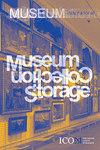弹性存储:使遗产机构能够有效管理高性能存储区域
IF 0.4
4区 艺术学
0 ART
引用次数: 0
摘要
摘要遗产机构发现自己越来越被迫降低与能源使用相关的成本,同时又不放弃最佳保护其委托藏品的首要任务。现在,复原力、自主性和成本效益比以往任何时候都更是可持续管理遗产的关键。比利时有1000多家博物馆,其机构可以通过优化室内气候管理来节省能源,这是一个重要的机会,可以缓解机构预算的压力,并帮助实现比利时和欧盟为自己设定的雄心勃勃的节能目标。遗产机构必须积极主动地实施这些战略,从一长串措施中进行选择,以优化其气候系统和室内环境。这可能是一项艰巨的任务。事实上,博物馆和遗产机构往往缺乏解决这些问题的内部专业知识,这就是为什么需要清晰、实用和直观的协议、工具和具体例子。作为一个案例研究和正在进行的研究,本文描述了比利时的弹性存储项目,该项目旨在验证一项优化博物馆存储区气候系统功能的协议。弹性存储由皇家文化遗产研究所(KIK-IRPA)和鲁汶大学开发,汇集了一支由公众代表、博物馆工作人员和能源性能和保护专家组成的跨学科团队。它旨在帮助利益相关者优化存储区域管理,同时减少碳足迹并优化保存条件。弹性存储旨在挖掘这些利益相关者之间的协同作用,促进合作,发展共同语言,并将专业知识传授给比利时的中小型博物馆。本文章由计算机程序翻译,如有差异,请以英文原文为准。
Resilient Storage: Enabling Heritage Institutions to Effectively Manage High-performance Storage Areas
Abstract Heritage institutions find themselves increasingly compelled to lower costs related to energy use, without disowning their primary task of optimally preserving the collections they are entrusted with. Now, more than ever, resilience, autonomy and cost-effectiveness are key to managing heritage sustainably. With over 1,000 museums in Belgium, the energy savings that its institutions may obtain by optimising their indoor climate management represents an important opportunity to alleviate strain on institutional budgets, and to help reach the ambitious energy-saving goals Belgium and the EU have set for themselves. Heritage institutions must be proactive in implementing such strategies, choosing from among a long list of measures to optimise their climate systems and indoor environments. This can be an overwhelming task. Indeed, museums and heritage institutions often lack in-house expertise to tackle these issues, which is why clear, practical and intuitive protocols, tools and concrete examples are required. As a case study and presentation of research-in-progress, this article describes Resilient Storage, a Belgian project that aims to validate a protocol to optimise the functioning of climate systems in museum storage areas. Developed by the Royal Institute for Cultural Heritage (KIK-IRPA) and KU Leuven, Resilient Storage assembles an interdisciplinary team of public representatives, museum staff and experts in energy performance and conservation. It aims to help stakeholders optimise storage area management, simultaneously reducing its carbon footprint and optimising its preservation conditions. Resilient Storage aims to unearth synergies among these stakeholders, promote collaboration, develop a common language and transmit expertise to Belgian's small and medium-sized museums.
求助全文
通过发布文献求助,成功后即可免费获取论文全文。
去求助
来源期刊

MUSEUM INTERNATIONAL
ART-
CiteScore
0.60
自引率
0.00%
发文量
0
期刊介绍:
In its new revised form Museum International is a forum for intellectually rigorous discussion of the ethics and practices of museums and heritage organizations. The journal aims to foster dialogue between research in the social sciences and political decision-making in a changing cultural environment. International in scope and cross-disciplinary in approach Museum International brings social-scientific information and methodology to debates around museums and heritage, and offers recommendations on national and international cultural policies.
 求助内容:
求助内容: 应助结果提醒方式:
应助结果提醒方式:


